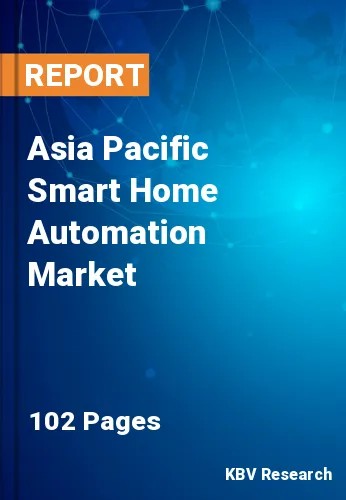The Asia Pacific Smart Home Automation Market would witness market growth of 15.7% CAGR during the forecast period (2022-2028).
Many newly constructed homes have the necessary infrastructure for smart homes. On the other hand, smart technologies can be retrofitted into older homes. While X10 or Insteon are still used by many smart home systems, Bluetooth and Wi-Fi have become more common. Two of the most popular home automation communication protocols in use today are Zigbee and Z-Wave. Both connect smart home equipment using mesh network technologies and short-range, low-power radio waves.
Despite targeting the same smart home applications, Z-Wave comprises a range of 30 meters compared to Zigbee's 10 meters, and Zigbee is frequently considered more sophisticated. While Z-Wave chips are solely offered by Sigma Designs, Zigbee processors are available from other suppliers as well. Artificial intelligence (AI) and machine learning are becoming more and more common in smart home systems, enabling home automation systems to adapt to their environments. For instance, voice-activated systems like Amazon Echo and Google Home have virtual assistants that can learn about and tailor the smart home to the tastes and routines of the users.
Many sections of the house can already be connected via smart gadgets. Smart sockets may switch gadgets on and off automatically. Smart alarm clocks can operate with music or even the news autonomously. Even complete routines that control the lights, appliances, thermostat, alarms, and other devices can be handled by voice assistants.
There are significant variations amongst the states. The rate and scope of urbanization are not constant. The urban population proportions of Assam (13%) along with the least urbanized states, Maharashtra (42%) and Gujarat (37%), and Tamil Nadu (44%), demonstrate the inter-regional diversity. With the widespread urbanization, the number of smart cities and smart homes as well as the integration of smart home automation technology in them would increase. This factor would majorly augment the growth of the regional smart home automation market.
The China market dominated the Asia Pacific Smart Home Automation Market by Country in 2021, and would continue to be a dominant market till 2028; thereby, achieving a market value of $15,776.1 million by 2028.The Japan market is estimated to grow a CAGR of 14.9% during (2022 - 2028). Additionally, The India market would experience a CAGR of 16.4% during (2022 - 2028).
Based on Component, the market is segmented into Hardware, Software and Services. Based on Application, the market is segmented into Entertainment, Lighting, Security, HVAC & Energy Management, and Smart Kitchen. Based on Technology, the market is segmented into Wireless, Cellular and Others. Based on countries, the market is segmented into China, Japan, India, South Korea, Singapore, Malaysia, and Rest of Asia Pacific.
Free Valuable Insights: The Worldwide Smart Home Automation Market is Projected to reach USD 187.8 Billion by 2028, at a CAGR of 15.2%
The market research report covers the analysis of key stake holders of the market. Key companies profiled in the report include ABB Group, Siemens AG, Schneider Electric SE, Johnson Controls International PLC, Honeywell International, Inc., Leviton Manufacturing Co., Inc., Legrand S.A., Crestron Electronics, Inc., Ingersoll Rand, Inc., and Lutron Electronics Co., Inc.
By Component
By Application
By Technology
By Country
Our team of dedicated experts can provide you with attractive expansion opportunities for your business.

